In This Issue:
Did someone forward this email to you? Subscribe now -- it's free!
Quail Continue to be Elusive on Wildlife Management Areas
Depending on which county or region you call home, your perception of quail hunting this year will surely vary. Per our pre-season report, South Texas showed the most promise for hunters, and at least on private lands, that appears to be the case. While warm weather and dry conditions limited hunters and effort early in the season, coveys were plentiful; our recent cold front will likely shift conditions as we enter the final month of the quail season. Ironically, the growing season grass growth we were so excited about this summer seems to be creating some challenges as hunters and dogs navigate the thicker South Texas brush country. That's not something we say very often, but we don't think too many are complaining. Throughout the other regions, hunting opportunities are county and ranch dependent and leave us little hope that 2021-22 will stand out in the memories of quail hunters years from now. We continue to look skyward for needed moisture in hopes those snow and rainfall events will act as a catalyst for a rebuild this spring. With that said, at our time of publication, ~70% of the state was under a "Severe" or "Extreme" drought designation. We'll need a quick turnaround if we hope to change our fortunes this coming nesting season.
 Welcome sign, Chaparral Wildlife Management Area, Cotulla, TX.
The story on our public lands isn't much different. Our hunter and harvest numbers are on par with previous years and most folks aren't finding birds consistently. These sentiments have been echoed by our WMA staff. Cody McEntire, area biologist for Elephant Mountain WMA, reported, "Our numbers are very low this year. At the end of December, we had 45 hunters for a total of 55 [hunter] days and 4 quail harvested. It's been hot and dry, and our summer rains came late, resulting in poor recruitment. Wish I had better information for [our hunters]." Similarly, from the Chaparral WMA, Area Biologist Diego Navarro stated, "Hunters are seeing mixed success, with many going home empty handed but several groups bagging a handful of birds. It is not uncommon for hunters to encounter several coveys (8-12 birds a covey) a day. Range conditions are currently poor, [and] we have not had any recent measurable precipitation." Our lone bright this year has been Black Gap WMA, but even there, hunters are putting in hard miles for few birds. These results were expected but the news is never welcome. Much like the surrounding country, we'll look to rebuild this spring. The Chaparral WMA will host one more hunt this year from Feb 8-9. Black Gap WMA will be open Feb 7-27, and Elephant Mountain WMA will be open through Feb 27, a date which also marks the end of the statewide season (please remember that hunters are required to deposit one wing from each quail harvested at respective registration stations before exiting the WMAs).
Below we detail our WMA hunt numbers as of Jan 31. A special thank you to all our WMA staff who provided updates and insights into their respective areas; in the trenches, they are the front line when it comes to conserving and protecting TPWD's public lands. For more information, a list of WMAs can be found on our website, and don't forget to check out our Outdoor Annual app for season dates, bag limits, and regulations for quail in Texas.
By: John McLaughlin, upland game bird program leader
 Quail hunters/harvest, TPWD Wildlife Management Areas, 2021-22; mid-season data may not represent season totals.
New Private Lands Quail Drawn Hunt an Undeniable Success
While TPWD has a diverse Drawn Hunt Catalog, offering everything from alligator to pronghorn and turkey hunts, there have been few, if any, opportunities for private lands quail hunts. This hunting season our Panhandle Wildlife District biologists took it upon themselves to remedy this deficiency and enroll a Lipscomb County Ranch into our public hunting system. Working together with our public hunting program, they negotiated with the landowner to provide this unique opportunity for quail hunters. All told, there were nearly 1,300 applicants for the 36 permits! We guess the old expression rings true, "Have bird dog, will travel." But the number of applicants is only half the story, the other is the feedback we receive from our hunters and landowners, and this comment stood out:
"I've been hunting for over 20 years and I can honestly say that this was one of the best quail hunts I've ever been on...I can think of only two other times in my life that I've seen that many coveys in a day."
In our opinion, it doesn't get much better than that - and this has been a "down" year! Thanks to our district biologists, who are our boots on the ground when it comes to making these connections, and thanks to the landowners across the state who offer their lands to help connect folks with hunting opportunities; from the panhandle to the coast, we can't imagine a better way to spend the day than outside enjoying all this beautiful state has to offer.
By: John McLaughlin, upland game bird program leader
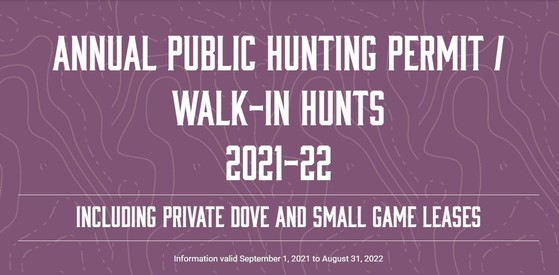 Annual Public Hunting permits, or APH, are available with your annual hunting license purchase.
Texas Mid-Winter Waterfowl Surveys Results - 2022
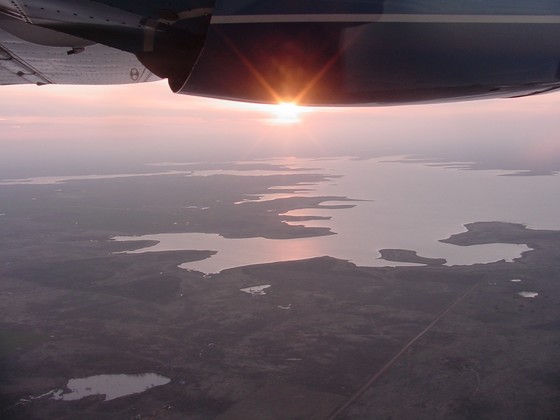 Aerial waterfowl surveys above the Oaks & Prairies region, Texas.
Two very timely early January cold fronts really changed the duck landscape across most of Texas. The overall duck estimate this January was up 50% from the previous year’s all-time low. We are now just 5% below the long-term average on total ducks estimated in Texas. The Oaks and Prairies region, for the second year in a row, had very few ducks and this year’s survey marked the lowest duck estimate in 26 years. We observed a big increase in ducks on the small stock ponds of the Rolling Plains, which were up 60% from the previous year and was the second highest duck estimate observed in 26 years for this region. Diving ducks along the Gulf Coast were up significantly due to the survey crew encountering a few very large concentrations of redheads in the south bays, resulting in the largest estimate of redheads in the survey's history. Without those two significant cold fronts our survey numbers would have been very different. Luckily it came before duck season closed.
For more on the Texas Mid-Winter Waterfowl Survey and waterfowl management, check out our Fall 2021 newsletter, or visit the Waterfowl in Texas webpage.
By: Kevin Kraai, waterfowl program leader
 Texas Mid-Winter Waterfowl Survey, total duck numbers by region, Texas Parks & Wildlife Department.
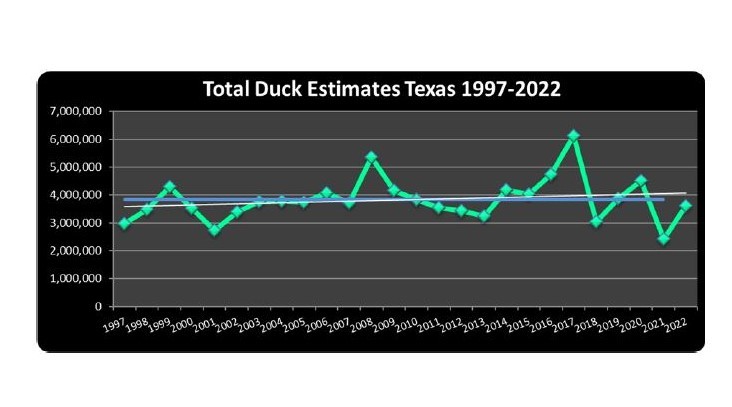 Texas Mid-Winter Waterfowl Survey, estimated total ducks statewide, Texas Parks & Wildlife Department.
 Texas Mid-Winter Waterfowl Survey, total duck and geese numbers by region, Texas Parks & Wildlife Department.
Tim and Karen Hixon Memorial at Guadalupe Delta WMA
As a result of a joint effort between TPWD and Ducks Unlimited, the Hixon Memorial is restoring 6 freshwater wetlands in the Buffalo Lake Complex at the Guadalupe Delta Wildlife Management Area (WMA). The landscape and geography of the Texas Coast make it an important area for migrating and resident wetland birds, with the region serving as an important wintering destination for the Central Flyway's waterfowl population; this population includes ducks and geese from major breeding locations across North America. The Guadalupe Delta WMA provides crucial freshwater and forage resources for dozens of bird species in an otherwise salty and brackish environment.
The project allows WMA staff to manage water levels on ~1,875 acres of freshwater wetlands on the Mission Lake Unit. This change is critical as our ability to regulate water levels has been diminished in recent decades and infrastructure challenges have led to erosion issues. The primary component of this project is the repair and reinforcement of Buffalo Lake Marsh, a 165-acre wetland in northwest corner of the WMA.
 Construction is underway to restore function to ~1,875 acres of freshwater wetlands at the Guadalupe Delta WMA.
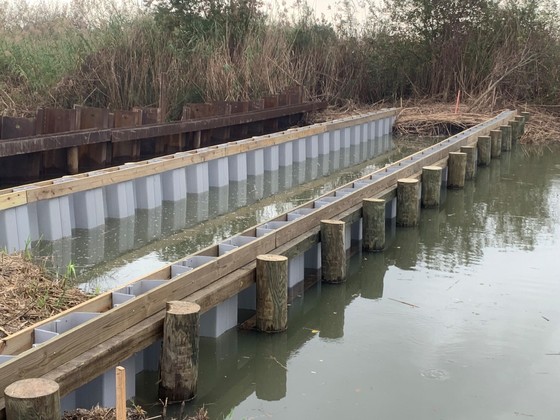 Construction is underway to restore function to ~1,875 acres of freshwater wetlands at the Guadalupe Delta WMA.
The unit itself is being dedicated as a living memorial to Tim and Karen Hixon for their loyalty to our TPWD family and their passion for conservation. Both have played key leadership roles within the conservation community:
- Tim Hixon served as a TPW Commissioner, as the second chairman of the TPW Foundation, and was inducted into the Texas Conservation Hall of Fame as a trustee emeritus in 2010. Along with his TPWD service, Mr. Hixon was a leader at The Nature Conservancy, the San Antonio Zoological Society, the National Fish and Wildlife Foundation, and the Caesar Kleberg Wildlife Research Institute. Hixon also served as the president of the Boone and Crockett Club and as director and executive vice president of Game Conservation International. He passed away in 2018.
- Karen Hixon served as a TPW Commission, as a member of the board of directors for The Nature Conservancy of Texas and TPW Foundation, and on the board of directors for the Peregrine Fund and the Texas Agricultural Land Trust Foundation. She currently resides in San Antonio.
For Mr. Hixon, “Conservation was simply part of his DNA,” says TPWD Executive Director Carter Smith. “It defined him in so many ways as a sportsman, a rancher, a businessman and as a philanthropist. He was the proverbial man for all seasons.”
Mobilizing everyone together for this project was a monumental feat with so many funding partners uniting for a common purpose; funding sources included TPWD Migratory Game Bird Stamp dollars, North America Wetlands Conservation Act and National Fish and Wildlife Foundation contributions, Ducks Unlimited donations, and private family contributions. Wildlife species expected to benefit include American wigeon, canvasback, lesser scaup, mallard, mottled duck, northern pintail, redhead, black-bellied and fulvous whistling ducks, and ring-necked duck. Other wetland species that will benefit include black-crowned night-heron, gull-billed tern, king rail, least bittern, least tern, little blue heron, pied-billed grebe, reddish egret, roseate spoonbill, seaside sparrow, semipalmated sandpiper, short-billed dowitcher, and snowy egret.
By: Rachel Fern, wetland program leader
Upland Game Bird Biologists Gather in Lubbock
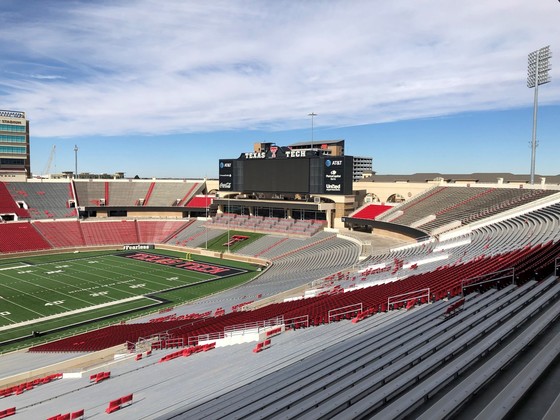 Members of various upland game bird working groups met on the Texas Tech University campus in January.
As a kick off to the new year, the Western Quail Working Group (Western Association of Fish and Wildlife Agencies) and the National Wild Pheasant Technical Committee (Midwest Association of Fish and Wildlife Agencies and Pheasants Forever) met in Lubbock, TX to tackle the many challenges facing upland game birds across the country. Simultaneously, the groups sought to identify common ground and opportunities for partnership and conservation. This annual meeting is unique in bringing together over a dozen state, federal, and NGO biologists to discuss quail and pheasant conservation, from on-the-ground management to the impacts of hunting, waning habitat, and policy, among others. These meetings are critical to maintaining a strong network of communication and collaboration with our partners and help set the direction for our collective efforts in the coming years. Texas Parks and Wildlife Department, with the help of Pheasants Forever and Quail Forever in Texas, was excited to play host and welcome our friends in conservation to the Lone Star State!
Topics discussed by the Western Quail Working Group included:
- Overview and status of western quail populations;
- Western state research updates (e.g., mountain quail habitat needs in WA);
- Habitat evaluation techniques for restoration and translocation;
- Quail monitoring techniques (e.g., autonomous recording units); and
- Hunter and harvest surveys, among others.
Topics discussed by the National Wild Pheasant Technical Committee included:
- Overview and status of respective state's pheasant populations;
- Range-wide research updates (e.g., multi-state brood surveys);
- Habitat conservation programs (e.g., State Acres for Wildlife Enhancement);
-
National Wild Pheasant Conservation Plan revision (completed in 2021); and
- Hunter recruitment efforts (i.e., R3 Initiatives), among others.
By: John McLaughlin, upland game bird program leader
Rio Grande: New JV Science Coordinator
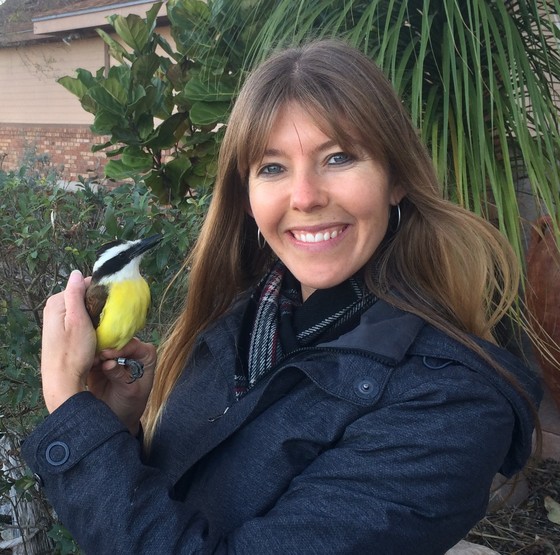 Dr. Rebekah Rylander, science coordinator, Rio Grande Joint Venture
The Rio Grande Joint Venture is pleased to announce that Dr. Rebekah Rylander has started work as their new science coordinator! She will be responsible for leading the science and monitoring for priority habitats and birds and coordinating with other Joint Ventures on grassland bird conservation.
Dr. Rylander grew up in central Texas and earned a Bachelor’s degree in Ecology, Evolution, and Behavior at UT Austin. While attending the university, she took her first ornithology course which inspired her to assist in various bird-related field projects in Australia, Ecuador, Hawaii, Mexico, and Canada. She also became locally engaged in conservation efforts focused on the golden-cheeked warbler and black-capped vireo through consulting work and internships at the Balcones Canyonlands Preserve in Austin, Camp Bullis Military Base in San Antonio, among other locations across Texas. Additionally, she served as a youth birding camp counselor for Victor Emanuel Nature Tours in California, Arizona, and Texas, as well as a private tour leader in the Chiricahua Mountains of southeast Arizona.
After here time in Austin, Dr. Rylander went on to earn her Master’s and Ph.D. examining social behaviors and population dynamics of the black-crested titmouse at Texas State University in San Marcos. During her time at the university, she became passionate about melding sound science with public outreach, and she made it her mission to engage undergraduates and citizen scientists in local conservation projects. Upon earning her personal Master Bander permit, Dr. Rylander trained and mentored numerous students and organizations on the importance of bird banding and trained over 140 volunteers to monitor cavity-nesting activities of native bird species. As a graduate student, she also initiated monitoring of a small population of golden-cheeked warblers in southeast Hays County, secured funding for the construction of two chimney swift towers on Texas State University properties, and established the San Marcos Christmas Bird Count in 2016 with the assistance of her lab mates.
Dr. Rylander is excited to be a member of the Rio Grande Joint Venture and says she, "cannot wait to build local and international collaborations with others who are passionate about conserving avifauna!"
By: Rio Grande Joint Venture Staff
Lower Mississippi Valley: East Texas Shortleaf Pine Tour
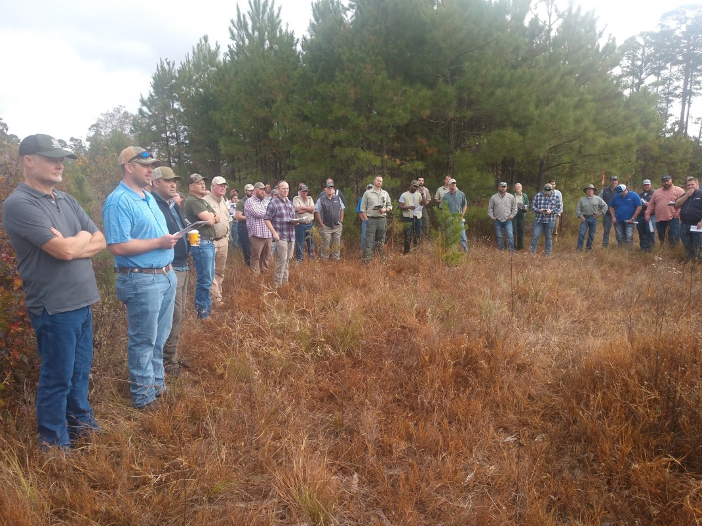 Landowner, biologists, foresters, and bankers gather at I.D. Fairchild State Forest to learn about shortleaf pines.
The Northeast Texas Conservation Delivery Network partners convened a shortleaf pine management workshop on Nov 16, centered on the I.D. Fairchild State Forest in Cherokee County. The Texas A&M Forest Service’s (TFS) Jason Ellis guided nearly 80 participants on an excellent tour of past and ongoing TFS efforts on the State Forest. Highlights of the day included on-site discussions on establishing and managing young shortleaf stands. Experienced foresters and wildlife biologists described techniques and applications that have been successful, and shared less successful applications that were learning events and should be avoided in future efforts. Mike Black, director of the Shortleaf Initiative, provided a great deal of insight from experiences with shortleaf pine around the Southeast. For more information and pictures from this great event, check out this short article.
By: Lower Mississippi Valley Joint Venture Staff
Playa Lakes: Guide to Restoring and Maintaining Healthy Playas
 Ongoing playa restoration work on the Southern Great Plains. Courtesy: Dru Stevens
While playas provide critical wetland habitat for wildlife, they also provide important benefits for the people who live in this region. Playas, when healthy, provide a sustainable water source for communities and rain-fed operations, water filtration, flood control, livestock forage, and recreation.
So, what is a healthy playa?
A healthy playa has an intact clay basin — without excavated pits or ditches — that is not buried by sediment from nearby fields. Water from the surrounding watershed freely enters the basin through a native vegetative buffer without being diverted from the playa by roads, terraces or other impediments.
Unfortunately, many playas don’t fit that description, but there are opportunities to work with landowners to restore their playas and maximize the many benefits provided by a healthy playa.
Playa restoration reverses past modifications to playas by removing accumulated sediment, filling drainage features, redirecting water back into the playa, and protecting the playa with a buffer composed of native vegetation.
Playa Lakes Joint Venture has developed a six-page Playa Restoration Guide to help landowners and natural resource managers restore and maintain healthy playas. The guide also includes information about what landowners can expect as they work with conservation delivery staff to plan and implement a playa restoration project.
For more information about playas, as well as playa maps and management tools, visit PlayasWorkForTexans.com.
By: Miruh Hamend, communications director, PLJV
National Bobwhite Conservation Initiative Launches StoryMap
 Male northern bobwhite calling. Courtesy: Missouri Department of Conservation
Why should we care about bobwhites? What does bobwhite conservation mean for our efforts to preserve other declining grassland birds species? And what is the National Bobwhite Conservation Initiative (NBCI), exactly? Lucky for us, the NBCI Technical Committee has developed a beautiful StoryMap to help partners and the public makes sense of it all. You will begin learning more about this incredible partnership, for which TPWD has played an integral role, and the tireless efforts underway to help bring back bobwhites and grassland birds!
By: John McLaughlin, upland game bird program leader
|